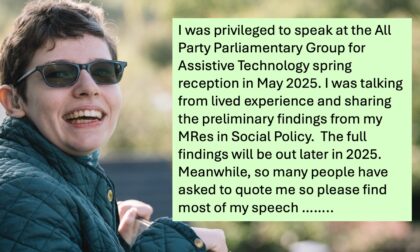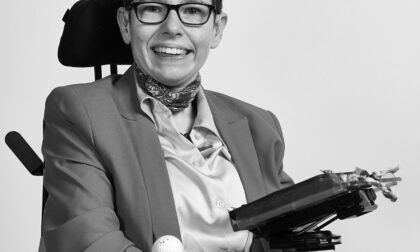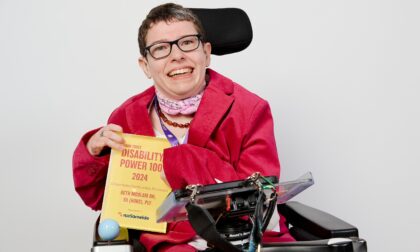Being given all the tools to communicate is brilliant. However, being human there are sometimes unexpected physical and environmental factors that impact our output. Occasionally however hard I try I just don’t seem to be able to make my body support direct input to communicate using AAC. By occasional I mean these issues might not happen for days, or there could be a series of events all within a few hours. There are several reasons why my direct input becomes variable:
- Extreme fatigue
- Hunger
- Illness
- Spasm
- Cold environment
- Stress
- Dystonic effects in other body parts
- Poor seating (including lack of foot support)
- Excitement
- Startle reflex
The impact of my cerebral palsy
Each of these events might have different causes but the outcome can be the same. Due to my cerebral palsy my body becomes stiff, or jerky, or the messages from my brain misfire. These miscarried messages can make my arms take big sweepy movements towards my device. Alternatively, the movements become jerky and lack direction, rather than my normal small and controlled hand movement. Fortunately, these situations are rare, but it can be frustrating not being able to communicate when it matters.
What direct input means for me
By direct input to communicate using AAC, I mean using either my finger, knuckle, or a stylus to select the letters and words I want on my software (Proloquo4Text) or on a letter card. To be able to functionally be accurate and efficient to input I need to be able to have full body control. As an aside I also use eye gaze with a hand switch. The switch is quicker for me than dwelling. However, I only use eye-gaze when I’m doing personal work and I’m not referring to this here.
Extreme fatigue
When I am physically tired everything slows down. What seems easy (and in my head normally graceful) becomes jerky making my limbs feel heavy and difficult to control. This happens when I’ve not had enough sleep, burned the candle at both ends, not taken time out to rest regularly or just tried to do the same as everyone else. I use spoon theory daily to manage my fatigue. If this seems familiar to you then you might want to look at my blog. My post AAC, spoons and speech fatigue is about how I use spoon theory when I verbalise.
Hunger
Without rest and nourishment, my body can only function for a limited time before it starts to run on adrenalin. Then when the adrenalin runs out it is like a light has been switched off. Bang, I’m good for nothing. The answer is regular food and drink, never allowing myself to put off eating to keep up my energy levels. I’ve recently discovered a warm drink as soon as I wake really helps me to be more relaxed and have the energy not to arrive at breakfast hangry. The result is I’m promoting my direct input to communicate using AAC more fluently at an earlier point in the day.
Illness
Being unwell affects everyone in some way. Once I’m ill direct input to communicate becomes trickier. This affects my ability to carry out everyday functions from eating and drinking to being physically active. I can tire easily just sitting when I’m really poorly. The result is just like extreme fatigue, it’s hard to even think. And, virtually impossible to make my limbs work to input into my AAC device. As a result of knowing these outcomes from illness, I work pretty hard to ensure I have balance in my life with sleep and good nutrition.
Spasm
My main diagnosis is dystonic cerebral palsy. For years as a child, this was referred to as athetoid CP. However, these balance and jerky movements don’t stop me from getting spasms now and then. When this happens, I lose control of my limbs as they become fixed. If it’s my right arm then it’s impossible to use my device. If it’s other body parts, then I might still be able to input but it is effortful and sometimes I miss hit or need a couple of attempts.
Cold environment
Cold affects me quickly, like other wheelchair users who are not self-propelling, I’m pretty static in my chair so the cold seeps in. Unlike someone more mobile my circulation is less good. To combat this even in summer I have a blanket on the back of my chair. I’ve always got on layers which makes me like ‘Michelin Man’ as we go through winter. My hat and gloves come out before the end of September and a scarf is a must. I experience this less these days as I am much more physically active doing gym work and frame running, but nevertheless keeping warm is essential for my communication.
Brain freeze
Occasionally I feel like a rabbit in the headlights, see my blog post ‘Thinking time or a mind blank’. I have a condition called synaesthesia and due to this I think in visuals, not in words. This means I sometimes need a second or two extra thinking time to process a situation. I need to think about the response and then translate my answer back from visuals into words on my communication device. To the outsider, I look like my body has momentarily frozen before I can make things work again.
Stress
We all get stressed sometimes, maybe the difficult encounter or the anticipation of a review meeting. As soon as this happens my body might react in a variety of ways with spasms, dystonic episodes, or brain freeze. Often when this happens my posture goes, one foot falls off my footplate and my left arm twists upwards in a spasm. If my team see this happen, then they have a couple of non-verbal cues they give me to help me remember to breathe and readjust my seating position. The way I manage stress is to rehearse difficult situations. I talk with my team about previous similar experiences. Then I think about things that might happen to cause me stress and how I’ve overcome them successfully in the past.
Dystonic effects in other body parts
My dystonia is episodic and has a variety of causes. These are pain, stress, physical and mental exhaustion, overall fatigue and being unwell, so really all of the above. This can cause any body part to decide to play the involuntary jerking game with arm or leg thrusts, torso twists, hiccoughs, and tongue writhing (mouth ulcer). Once this starts, I need to get it under control quickly and we have practised strategies for this. However, until I’m back in control then my body finds it hard to focus on normal activities like accurate direct input to communicate using AAC.
Poor seating (including lack of foot support)
If I try to use my devices when I’m not sat with good postural support, then my body is having to overcompensate to keep me upright and steady. The result is suddenly the control I need for using my AAC resources has dissipated. Consequently, input becomes a secondary and inefficient task. This means that around my house I have seating that works for me which includes foot boxes, footrests, cushions, armrests, and postural support. My profiling bed has helped enormously for direct input to communicate using my devices in bed.
Excitement
Like everyone else, excitement can affect the way my body works. Either there is a release of tension and I’m a bit floppy, or alternatively, the tension builds and I’m like a board. If I’m laughing I often ‘forget’ to breathe, quite an important activity for us all! We all need to have excitement in our lives, so this is just ‘one of those things’ I need to live with. However, please don’t expect me to direct input to communicate using AAC when I’m laughing.
Startle reflex
Many people with cerebral palsy retain the ‘Moro’ or startle reflex that is usually only seen in babies. Just like an infant for me this is triggered by sudden loud noise, and as a result, the most obvious reaction is my arms flying out away from my body. This results in me knocking things over, and usually dropping my stylus, and momentarily my body goes rigid until I can take a deep breath and assimilate the cause.
As an aside, my startle reflex can appear spasmodic to others. If I’m wearing my hearing aids I’ll jump sky-high at things other people think are normal. But, if I’m not wearing them for some reason, then things other people react to can be out of my range of hearing.
Managing situations
Fortunately, I don’t live in a heightened state of emotion continuously, and all these factors can be ‘managed’. The important thing is that my family and the team around me know the causes. They can help me speedily and discreetly manage situations. The result is I’m back on track and communicating effectively and for the most part a stranger will be unaware of what has taken place.
The benefits of being fit and healthy
One of the biggest benefits I’ve discovered for direct input to communicate was improving my core and shoulder strength and remaining healthy. This came about through using my frame runner for cardio exercise and doing gym work. The stronger I have become the more fluid my direct input has become. Just because I’m no longer an elite athlete I will always continue to run for my health and work out. The life benefits are huge, and I want to continue evolving my communication.
So, if you see someone struggling to do something they normally do with ease, ask yourself why. Try to take account of physical and environmental factors because at least for me their impact can be huge when trying to direct input to communicate.
You can find out more about how I communicate here





If you found this interesting or
helpful please feel free to share.